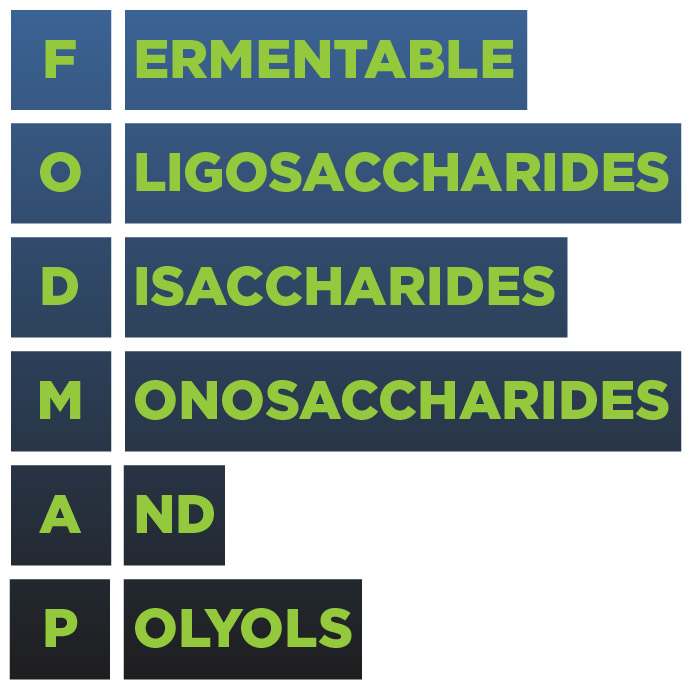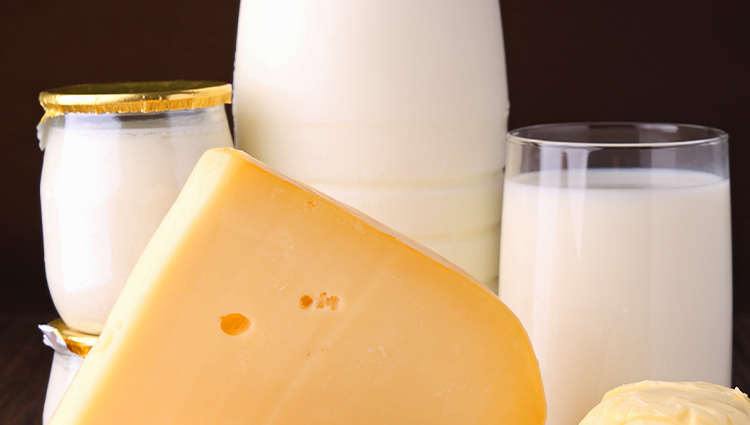The Low-FODMAP Diet is an evidence-based dietary therapy primarily used for symptom management in irritable bowel syndrome (IBS). IBS is a functional gastrointestinal (GI) disorder with symptoms including gas, bloating and abdominal pain.

FODMAP Defined
FODMAP is an acronym that stands for different types of short-chain carbohydrates that are commonly malabsorbed due to issues with motility or lack of adequate digestive enzymes (but this malabsorption does not always cause symptoms).
D is for lactose
Lactose, or the D (disaccharides) in FODMAP, is the naturally occurring sugar exclusively found in dairy. To breakdown lactose, our bodies need sufficient amounts of the enzyme lactase, and when this enzyme is insufficient it becomes difficult to digest and absorb the sugar properly. This can result in unpleasant symptoms – such as diarrhea, gas, bloating and abdominal cramps. While lactose can only be found in dairy products, not all dairy is a source of lactose. So essentially, those with IBS or lactose intolerance can have their cake and eat it, too, by choosing low-lactose or lactose-free dairy foods.
As dietitians, we are big fans of dairy – like milk, yogurt and cheese! It contains protein, calcium, magnesium, phosphorous and potassium in amounts that are hard to get from other foods, which is why we recommend adjusting dairy consumption versus completely removing it and its nutrients from the diet.
What lactose intolerance isn’t
Because intolerance is not an allergy, lactose intolerance does not require complete avoidance of dairy foods in most cases. In fact, most individuals who have lactose intolerance can tolerate some lactose daily – up to 12 grams per day – but not all at one time. Tolerance exists on a spectrum, with some individuals tolerating more or less than others.
It is also important to distinguish lactose intolerance from lactose malabsorption. Malabsorption is the spillover of undigested lactose from the small intestine into the large intestine. This happens to some degree in all people. The difference between lactose malabsorption and lactose intolerance is whether or not the individual has symptoms. Lactose malabsorption can be tested for with a breath test, but up to 60% of people who test positive have no symptoms. Only those who are symptomatic need to modify the amount of lactose in their diets.
3 Ways to Eat Dairy on a Low-FODMAP Diet
If you are following a Low-FODMAP Diet, there are plenty of options. Here are just three.
Lactose-free foods
Milk, cottage cheese, yogurt and ice cream are dairy foods with the most lactose, but there are also many lactose-free dairy options for all these foods – and they taste great. Here’s a chart showing lactose amounts in dairy foods so you can find foods with the lowest amounts. These are the same real dairy foods we know and love, but they do not contain lactose as they have been processed through mechanical filtration to remove lactose or the lactase enzyme has been added to break down the lactose.
Lactase supplements
Individuals can try supplementing with an over-the-counter lactase enzyme (often in the form of drops or tablet) right before they take their first bite of lactose-containing dairy. But those with IBS, specifically, should be careful to avoid other FODMAP ingredients – such as the polyol “mannitol,” as it is a common additive in the inactive ingredients of lactase supplements.
Low-lactose cheeses and yogurt
Great news! Hard, aged cheeses – such as cheddar, Swiss and Parmesan – are low in lactose, so they can fit in a Low-FODMAP Diet – even feta and mozzarella fit. Greek yogurt is a great low-lactose choice as well. During processing, much of the lactose is removed. Additionally, the live active cultures in Greek yogurt produce lactase, the enzyme necessary for the digestion of lactose.
Lactose-Free Does Not Equal Dairy-Free
People on the Low-FODMAP Diet are only limiting lactose, not going dairy-free. Dairy-free items are derived from nuts or plants and while they do not contain lactose, they also do not contain the same nutrients as lactose-free dairy foods.
If your clients are on a Low-FODMAP Diet, it is best to encourage them to work with a registered dietitian with expertise in the nuances of this diet. To find a dietitian with this area of expertise, visit Monash.com.
When it comes to the delicious and nutritious benefits of dairy, choose what works for you, your patients and/or your clients – and feel confident knowing that lactose-free can be a great option!
About the co-author
Gillian White is a registered and licensed dietitian nutritionist currently practicing at Cooper Clinic in Dallas, Texas. She has a strong background in clinical nutrition and specializes in nutrition for gastrointestinal disorders, recently completing specialized training through Monash University for irritable bowel syndrome and the Low-FODMAP Diet.
Sources
- Shaukat A., et al. (2010) Systematic Review: Effective Management Strategies for Lactose Intolerance. Annals of Internal Medicine, 152(12), 797-803.
- Szilagyi, A., & Ishayek, N. (2018). Lactose Intolerance, Dairy Avoidance, and Treatment Options. Nutrients, 10(12).
- Morelli, L., et al. (2019). Lactose Intolerance: Clinical Symptoms, Diagnosis and Treatment. Global Diabetes Open Access Journal, 1(1), 1-10.
- Mattar, R., de Campos Mazo, D. F., Carrilho, F. J. (2012). Lactose intolerance: diagnosis, genetic, and clinical factors. Clinical and Experimental Gastroenterology, 5: 113-121.
- Misselwitz, B., et al. (2019). Update on lactose malabsorption and intolerance: pathogenesis, diagnosis and clinical management. Gut, 6: 2080-2091.
- Di Costano, M., Canani, R. B. (2018). Lactose Intolerance Common Misunderstandings. Annals of Nutrition & Metabolism, 73(4): 30-37.




